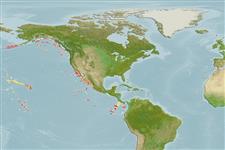Environment: milieu / climate zone / depth range / distribution range
Ecology
Marine; bathydemersal; depth range 700 - 1244 m (Ref. 40826). Deep-water
Eastern Central Pacific: Mexico, including the Revillagigedo Islands.
Size / Weight / Age
Maturity: Lm ? range ? - ? cm
Max length : 13.3 cm SL male/unsexed; (Ref. 40826)
Dorsal soft rays (total): 5 - 6; Anal soft rays: 4; Vertebrae: 18 - 19. Body flabby with thin, translucent skin. Subopercular lateral-line count usually 5. Skull relatively long, at least 30% of SL. Lower lip with membranous fringe of fingerlike papilla. Gill rakers in the form of broad tooth plates attached directly to gill arch,; no pedicels evident. Slender fins moderate in length with thin and transparent membranes. Cephalic lateral-line counts: subopercular usually 5 (5-6); preopercular 2. Tail lateral-line counts 8-11 (Ref. 40826).
Life cycle and mating behavior
Maturity | Reproduction | Spawning | Eggs | Fecundity | Larvae
Bradbury, M.G., 1999. A review of the fish genus Dibranchus with descriptions of new species and a new genus, Solocisquama (Lophiiformes, Ogcocephalidae). Proc. Calif. Acad. Sci. 51(5):259-310. (Ref. 40826)
IUCN Red List Status (Ref. 130435: Version 2024-2)
Threat to humans
Harmless
Human uses
Tools
Special reports
Download XML
Internet sources
Estimates based on models
Preferred temperature (Ref.
123201): 3.6 - 4.4, mean 3.9 °C (based on 25 cells).
Phylogenetic diversity index (Ref.
82804): PD
50 = 0.5001 [Uniqueness, from 0.5 = low to 2.0 = high].
Bayesian length-weight: a=0.02344 (0.00968 - 0.05678), b=2.94 (2.73 - 3.15), in cm total length, based on LWR estimates for this (Sub)family-body shape (Ref.
93245).
Trophic level (Ref.
69278): 3.3 ±0.6 se; based on size and trophs of closest relatives
Resilience (Ref.
120179): Medium, minimum population doubling time 1.4 - 4.4 years (Preliminary K or Fecundity.).
Fishing Vulnerability (Ref.
59153): Low vulnerability (10 of 100).
